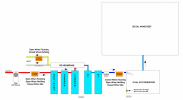Time has come. The tank I've carried around through 3 different houses is going to get set up.
Here is where I need the sanity check. The image below is a rough drawing of how I THINK the hookup should go as far as refilling the ATO when empty and to eliminate TDS creep.

Timeline of events:
ATO reservoir is empty and optical eye is triggered.
Apex closes the solenoid to the reservoir, opens the flush solenoid and the water in solenoid for...lets say one minute.
After one minute, Apex closes flush solenoid and opens the reservoir solenoid.
ATO reservoir is filled and water flow is shut off by float valve.
Pressure switch in-line triggers Apex to turn off the reservoir solenoid and the water in solenoid.
Rinse and repeat.
In Case of Leak:
Leak detectors below RO/DI and next to ATO reservoir tank. Either is triggered and all solenoids close.
Solenoids stuck open then LeakController LCS before water in solenoid triggers and cuts water completely.
Roast me.
Equipment list. Most of it is overkill but I have it, so I might as well use it.
Tank - JBJ RL-30 AIO
Heater - 200w
Lighting - ReefBreeders Photon (Oh yeah, the original from 2012)
Skimmer - Tunze 9004
Return Pump - Sicce Syncra 3.0 (700gph)
Filter Media - 2x Aquamaxx Reactors for GFO and Carbon
ATO - JBJ Dual Nano, 5g ATO reservoir
Water Movement - Vortech MP10 (Converted from ES to QD)
Control - Apex w/Leak Detection & 3x solenoids for ATO reservoir fill
Here is where I need the sanity check. The image below is a rough drawing of how I THINK the hookup should go as far as refilling the ATO when empty and to eliminate TDS creep.

Timeline of events:
ATO reservoir is empty and optical eye is triggered.
Apex closes the solenoid to the reservoir, opens the flush solenoid and the water in solenoid for...lets say one minute.
After one minute, Apex closes flush solenoid and opens the reservoir solenoid.
ATO reservoir is filled and water flow is shut off by float valve.
Pressure switch in-line triggers Apex to turn off the reservoir solenoid and the water in solenoid.
Rinse and repeat.
In Case of Leak:
Leak detectors below RO/DI and next to ATO reservoir tank. Either is triggered and all solenoids close.
Solenoids stuck open then LeakController LCS before water in solenoid triggers and cuts water completely.
Roast me.
Equipment list. Most of it is overkill but I have it, so I might as well use it.
Tank - JBJ RL-30 AIO
Heater - 200w
Lighting - ReefBreeders Photon (Oh yeah, the original from 2012)
Skimmer - Tunze 9004
Return Pump - Sicce Syncra 3.0 (700gph)
Filter Media - 2x Aquamaxx Reactors for GFO and Carbon
ATO - JBJ Dual Nano, 5g ATO reservoir
Water Movement - Vortech MP10 (Converted from ES to QD)
Control - Apex w/Leak Detection & 3x solenoids for ATO reservoir fill


